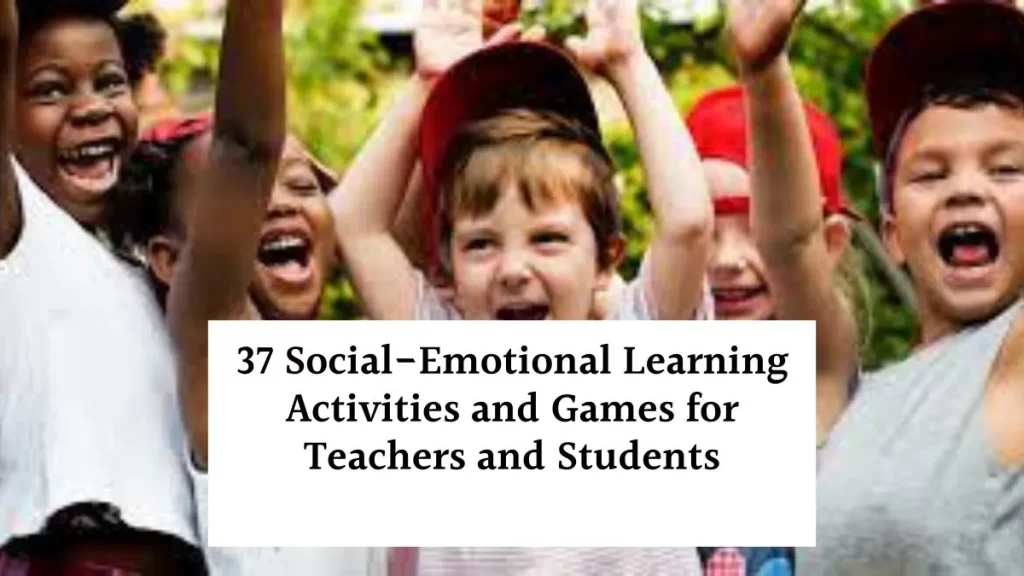37 Social-Emotional Learning Activities and Games for Teachers and Students: Schools are becoming more diverse, with students from different backgrounds each year.
Educators must provide students with the structure and support they need to succeed academically and in life. A powerful SEL facility provides just that.
Social-emotional development activities provide a safe and supportive environment for students to learn social behaviors. The game encourages healthy relationships that build empathy, sharing, and compassion. Even incorporating a social-emotional activity into a lesson plan can make a significant difference in a child’s life.
Contents
Preschool Learning Activities (for ages 4-5)
1. Start with a Check-in
Start the day with a friendly connection. Check in on each child with a simple greeting and ask how the student was feeling that day.
2. Finish with a Check-out
The same positive sentiment applies to the end of the school year. Ask students to reflect on their day, discuss what went well, and set goals for tomorrow.
3. Reward Kids for Kindness
Take a page from did you fill out a group today? The book encourages people to be kind to others. Write messages of appreciation and compassion, put them in the bin and read them over the weekend.
4. Encourage Show and Tell
Seeing is believing. Show and tell allows young students to explore different cultures and backgrounds while realizing what they have in common.
5. Teach Appreciation
Happiness Magazine found that gratitude improves happiness in children before the age of five. Teaching kids to say thank you and reward hard work can increase their levels of gratitude.
6. Teach Apologies
Apologies are essential at any age. Show one person how to make sure children have the tools to mend and repair relationships.
Kindergarten Learning Activities (for ages 5-6)
7. Make Story Time a Teachable Moment
Reading aloud allows you to explore social and emotional moments with your class. Get started with a series of picture books for your social-emotional library.
8. Develop a Buddy System
A buddy system makes for a more inclusive school. Pairing students for social-emotional learning activities during elementary school events gives children someone to call friends and a sense of belonging.
9. Let Students Talk
Give children opportunities to speak in structured socio-emotional learning activities and unstructured environments. There are many ways to foster dialogue and build their understanding and confidence.
10. Play Games
Play fosters creativity as children improve their imagination and physical skills. Social and emotional learning games sustain this healthy development.
11. Sing the Feelings Song
Help children connect their feelings into an emotion. An emotional song that allows them to recognize sadness when they see tears and happiness when they notice smiles.
12. Promote Active Listening
Social-emotional activities require listening and cooperation. Use the SLANT strategy, in which students sit up straight, listen, ask and answer questions, nod, and follow the speaker.
Elementary School Learning Activities (for ages 5-10)
13. Work in Groups
Teamwork occurs at all stages of life. Group activities develop students’ leadership skills and help students discover their strengths to be able to contribute.
14. Teach New Words
Learning new words provides a foundation for understanding. Giving your class a word of the day allows them to express their ideas more eloquently.
15. Create a Peace Place
Everyone needs time to decompress. Create a peaceful place where students can go if they are feeling upset or if someone is hurting them.
16. Build an Anchor Chart
Anchor charts capture the most important parts of the lesson. Visual aids reinforce central teaching points and create a literacy culture.
17. Role-Play
Role play helps children understand what it means to put themselves in someone else’s shoes. The beneficial exercise also stimulates children’s imagination and creativity.
18. Assign Responsibilities
According to Michigan State researchers, giving children age-appropriate responsibilities requires communication, role modeling, and choice making, all three of which complement social learning activities and feeling.
19. Have Daily Affirmations
We often let negative thoughts undermine our state of mind. Daily affirmations encourage awareness and validation of our values and self-worth.
20. Join Big Brothers Big Sisters
Social-emotional learning games don’t start and end with a school day. Children from disadvantaged backgrounds can join Big Brothers Big Sisters and have a mentor year-round.
Middle School Learning Activities (for ages 11-13)
21. Turn Conflict into Resolution
Every conflict has an opportunity to learn. Once students recognize the need for mediation, they can take these six separate steps to establish an agreement.
22. Monitor Student Progress
Track your class as each student progresses through the school year. Reward the best when they exceed their goals and learning milestones.
23. Hold Class Meetings
Regular class meetings allow students to share their ideas and concerns. It also develops leadership and public speaking skills.
24. Write a Journal Entry
Diary entries create a safe space for students to record their thoughts and feelings. Stimulate your child’s imagination with different challenges, such as writing lists or creative prompts.
25. Manage Stress
The American Institute of Stress reports that 77% of people suffer from stress that reduces their physical health. Help people relax with the coping strategy wheel.
26. Create a Vision Board
Set goals with this intuitive tool. Creating a vision board helps teens take responsibility for their actions as they strive to meet daily, weekly, monthly, and yearly goals.
27. Read a Book
Take your students to another world through the power of reading.
28. Celebrate Diversity
Our multicultural society has made it more important than ever to celebrate diversity. Ask students to share family stories or recipes to introduce others to their unique lifestyle and heritage.
High School Learning Activities (for ages 14-18)
29. Meditate
Meditation forces people to slow down and turn their attention inward. Although far from traditional social-emotional learning activities, mediation allows students to simultaneously recognize their community and themselves.
30. Be a Mentor to Younger Kids
Teach students to think about others by becoming a mentor. High school students can partner with elementary school students who need help in school and in life.
31. Talk with Strangers
Chatting with strangers opens us up to different ideas, perspectives, and backgrounds. Challenge your students to talk to a new person every day. They will quickly see that we are not so different from each other.
32. Practice Mindfulness
Mindfulness includes internal and external awareness. Its practice comes with a long list of benefits, such as lowering blood pressure, relieving chronic pain, and reducing stress.
33. Share a Quote of the Day
Give students something to think about with a quote of the day. You can open a class to discuss and ask students to share their thoughts on the meaning and meaning of the quote.
34. Have a Yay of the Day
The headwind/tailwind asymmetry suggests that people disproportionately focus on the negatives of life, rather than the positives. Turn this theory upside down by asking the kids to write down one “right” moment they have each day.
35. Assign Interview Projects
Interview-based projects teach communication skills while promoting exploration of different cultures. Bonus points if students interview people who are not in the same situation.
36. Write a Poem from Another Person’s Perspective
Let your class choose someone they don’t know and write a poem from their point of view. The exercise provides a practical way to understand the experiences of others.
37. Encourage Artistic Expression
Not all social-emotional learning games require speaking or writing. Some students may benefit from expressing themselves through painting, drawing or sculpting.
How to Use SEL Learning Activities in Schools
Positive Action gives teachers the resources and tools they need to integrate social-emotional learning into the classroom. Our program includes specific steps to foster social skills and relationships. Best of all, it fits any learning environment and takes only a few minutes to implement.
Positive Action has everything you need to get started. The complete system makes it easier than ever to teach social-emotional learning games. Take the next steps by looking at different social-emotional learning programs and begin to notice a positive impact.

